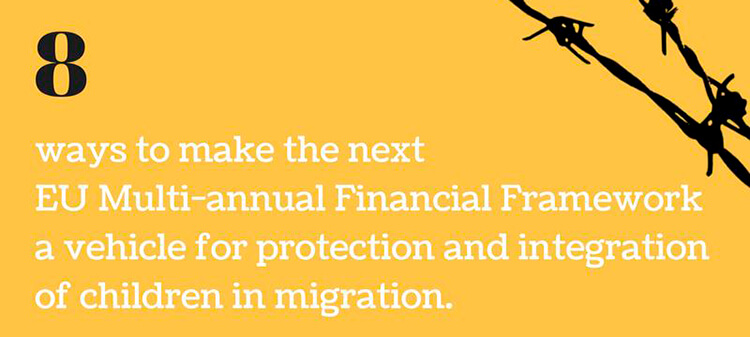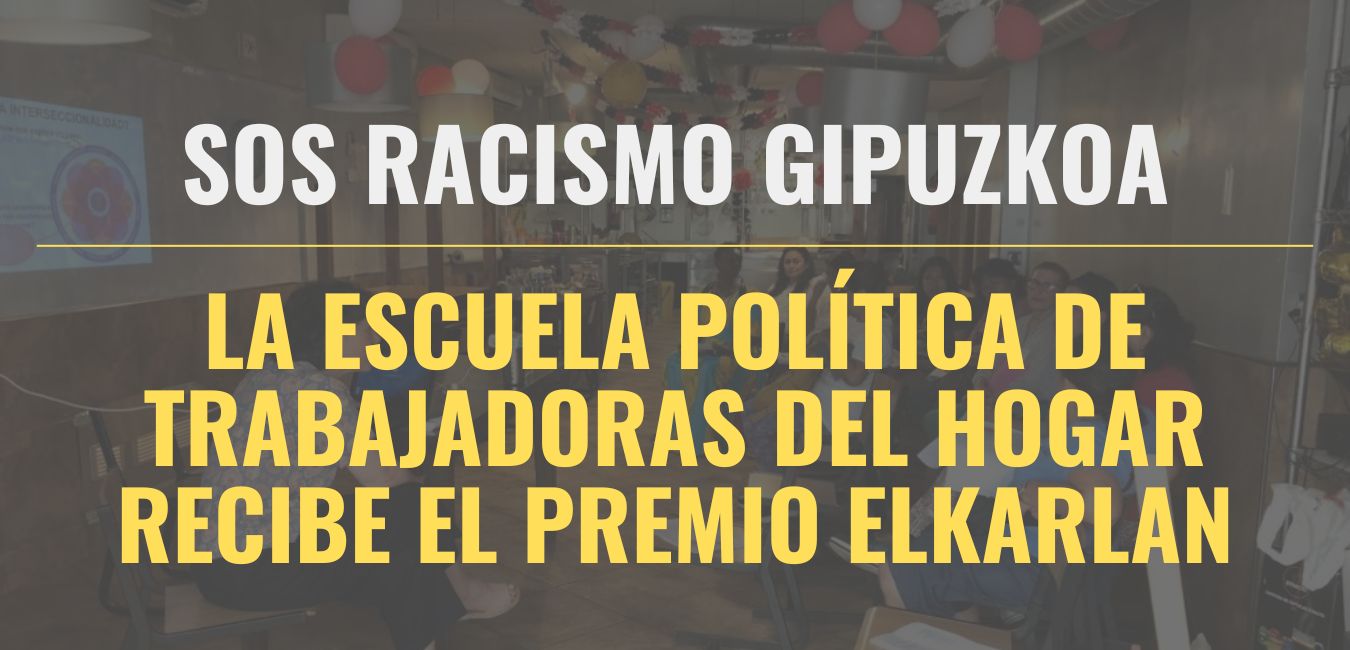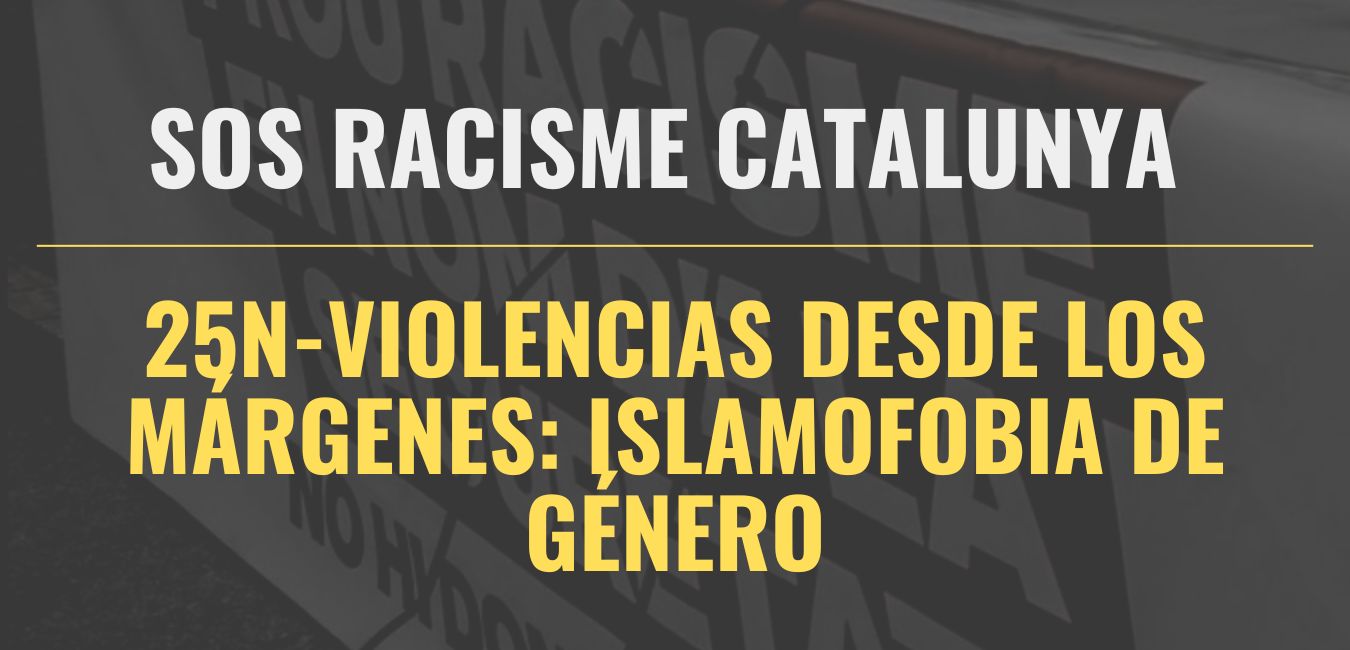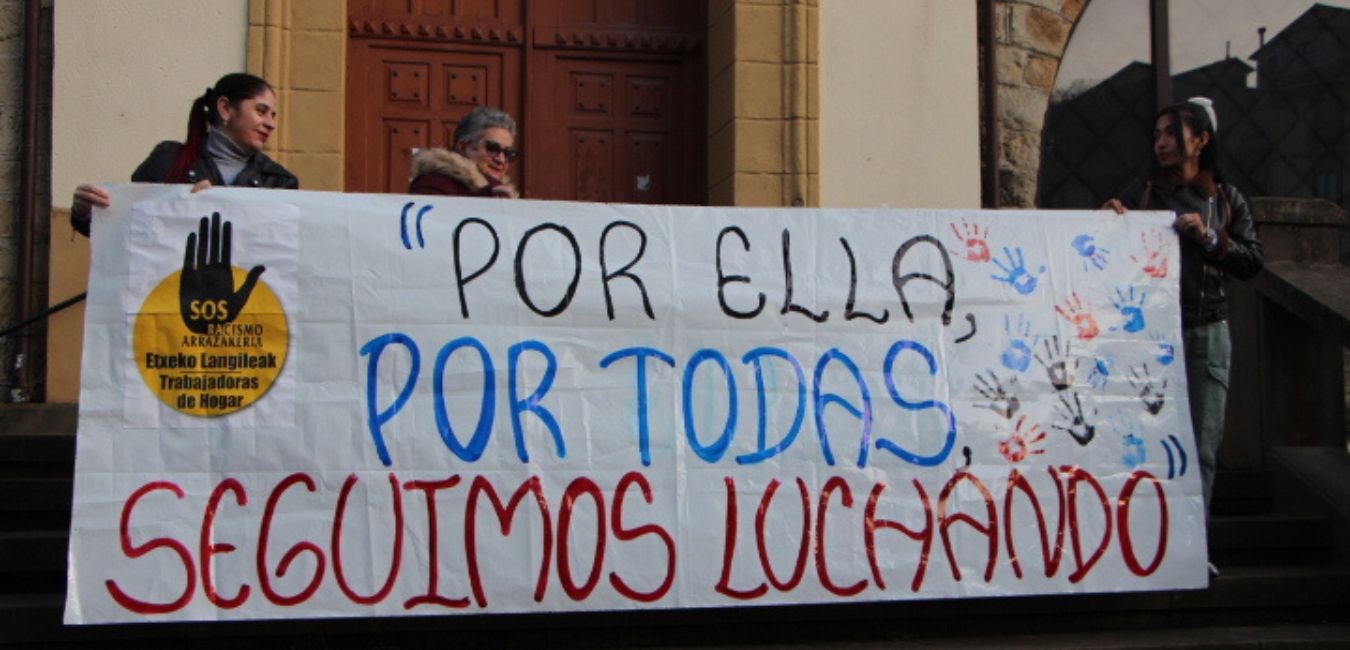(ES/ENG) A principios de mayo, la Comisión Europea publicará su Comunicación para el Marco Financiero Plurianual (MFP) posterior a 2020. Los planes iniciales indican posibles cambios en una serie de instrumentos financieros que tienen un impacto en la protección e integración de los niños migrantes, incluida la transferencia del presupuesto para la integración de nacionales de terceros países al Fondo Social Europeo, la creación de un Fondo Integrado de Gestión de Fronteras y la unión de varios fondos en un instrumento externo. Creemos que el marco debe cumplir plenamente los derechos y principios consagrados en la Carta de Derechos Fundamentales de la UE y en todos los instrumentos internacionales, incluida la Convención de las Naciones Unidas sobre los Derechos del Niño. –
In the beginning of May, the European Commission will publish its Communication for the post-2020 Multiannual Financial Framework (MFF). The initial plans of the European Commission indicate potential changes to a range of financial instruments that have an impact on the protection and integration of children in migration, including the transfer of the budget for integration of non-EU nationals to the European Social Fund, the setting up of an Integrated Border Management Fund and the consolidation of multiple instruments into one External Instrument with a suggested focus or potentially earmarked funding on migration. The MFF needs to fully comply with the rights and principles enshrined in the EU Charter of Fundamental Rights and relevant international instruments, including the UN Convention on the Rights of the Child.
[wc_row]
[wc_column size=»one-half» position=»first»]
En todo el mundo, hay aproximadamente 31 millones de niños viviendo fuera de su país. de nacimiento, y hay aproximadamente 5,4 millones de niños migrantes en Europa. La UE tiene la responsabilidad de garantizar que la financiación de la UE llegue a los menores migrantes, protegiéndolos en igualdad, satisfaciendo sus intereses más allá de su estatus migratorio.
PICUM junto a 35 organizaciones, instamos a la Unión Europea a priorizar los derechos de los menores migrantes en el período presupuestario posterior a 2020, utilizando todos los instrumenos disponibles de la Comisión (protección de los menores migrantes, caja de herramientas sobre el uso de fondos para la integración de personas con antecedentes migratorios) y los Objetivos de Desarrollo Sostenible (ODS).
Hacemos un llamamiento a la UE para que se comprometa y garantice los siguientes instrumentos de financiación internos y externos:
1. Asegurar que la financiación de la UE cumpla con el Derecho Internacional en materia de derechos fundamentales
El artículo 24 de la Carta de los Derechos Fundamentales de la UE destaca el interés superior del menor debe prevalecer en la acción de las autoridades públicas o privadas. Los fondos de la UE deberían utilizarse en consonancia con la Convención sobre los Derechos del Niño (CNUDN), la Convención sobre los Derechos de las Personas con Discapacidad (PNUDD) -ambas de Naciones Unidas- y la Carta de los Derechos Fundamentales de la UE, entre otros. Deben respetar los principios rectores de las leyes humanitarias incluido el principio de «no hacer daño».
El Comité de los Derechos del Niño de la ONU en sus Comentarios Generales Conjuntos No. 22 y 23 (2017) y el Comité de Trabajadores Migrantes de la ONU en el No. 6 (2005) reafirman que los menores no deben ser discriminados debido a su estatus migratorio por lo que deberían disfrutar del mismo nivel de protección y cuidado que cualquier otro niño que resida en el país. Por lo tanto, el presupuesto de la UE para los menores deberían basarse en ese princpio de no discriminación
2. Financiación directa de la UE para el fortalecimiento de los sistemas nacionales de protección de la infancia.
La financiación de la UE debe utilizarse para reforzar sistemas sólidos de protección a la infancia que protejan a todos los menores independientemente de su estado. Invirtiendo en sistemas de protección infantil, aseguramos una inversión social a corto y largo plazo. Los niños migrantes también deben tener el mismo acceso a la educación, servicios de salud y los servicios sociales, independientemente de su estatus migratorio.
3. Prohibición del uso de fondos de la UE para la detención de menores migrantes.
La detención de cualquier menor por su estado migratorio o el de sus familias, constituye una violación de los derechos del niño y contraviene el principio del interés supremo del menor. Por lo tanto, la financiación de la UE nunca debe utilizarse para acciones que fomenten o den lugar a detenciones u otras privaciones ilegales o arbitrarias de la libertad de los niños.
4. Evitar el uso de fondos de la UE para la segregación e institucionalización de los niños en la migración
Los Fondos Estructurales del período de financiación 2014-2020 prohibieron el uso de fondos para medidas que contribuyen a la segregación o la exclusión social de las personas, lo que descarta,, de hecho, la financiación de estas instituciones. Para el período de financiación posterior a 2020, debe garantizarse que la financiación de la UE no se utilice para apoyar entornos que conduzcan a la segregación física y social de los menores migrantes.
La financiación de la UE debería respaldar medidas alternativas para evitar la estancia de niños en centros de acogida, campamentos de refugiados «hotspots» o puntos conflictivos.
5. Financiación de la UE para el desarrollo de trabajo comunitario que facilite la integración de los menores
Según la orientación del CRC, los fondos de la UE deben desarrollar y poner en marcha soluciones no privativas de la libertad para menores y familias con menores mientras se resuelve su situación migratoria, sobre la base de una ética de cuidado y protección, llevada a cabo por actores competentes en materia de protección infantil. Deben enfocarse en el mejor interés del niño y proporcionar todas las condiciones materiales, sociales y emocionales necesarias para garantizar la protección integral de los derechos del niño y niña, permitiendo su desarrollo holístico.
Especialmente para los MENA, la financiación de la UE debe servir para una atención individualizada y de calidad basada en la familia y la comunidad dentro del sistema de protección de la infancia del país. Además, los instrumentos de financiación de la UE deberían garantizar que, especialmente los países fronterizos, reciban financiación suficiente para establecer sistemas de tutela de calidad.
Las familias deben mantenerse unidas. Esto significa que la UE debería promover un enfoque basado en la familia e integración, incluyendo apoyo psicosocial, acceso al mercado laboral y acceso a la vivienda. El acceso a la educación y los servicios de salud tiene un papel central en la facilitación de la integración y debe financiarse adecuadamente.
Se necesitan recursos específicos para el trabajo con menores víctimas de violencia, abuso, wxplotación y trata.
6. Invertir fondos de la UE en enfoques centrados en los niños y los jóvenes que sean participativos, empoderadores e innovadores
Se debería invertir en empoderar a los menores para que participen en las decisiones que les afectan, incluendo para ello la elaboración de material adaptado y el desarrollo organizaciones lideradas por jóvenes o que trabajan en cuestiones relacionadas con los menores migrantes.
Se debe proporcionar financiación suficiente para garantizar la asistencia y representación legal de calidad y efectiva, incluso a través de acciones de información y capacitación.
7. Asegurar el uso de los fondos y promover la participación de la sociedad civil y los usuarios en la asignación y seguimiento de la financiación de la UE.
El actual marco financiero incluye varios fondos que fortalecen los sistemas de protección infantil estatales. Sin embargo y a pesar de la situacióm actual, algunos apenas se usan. El próximo MFP necesita tener herramientas de seguimiento y acompañamiento para apoyar suuso, transparencia y rendición de cuentas. Esto debería incluir un mecanismo para financiar a la sociedad civil, cuando no se lo asigne a través de otras vías, incluyendo acciones para proteger a los menores migrantes, más allá de su estatus.
Es necesario asegurar que el Principio de Asociación sea la base de todos los instrumentos presupuestarios de este periodo. De esta forma garantizaríamos que la sociedad civil y las personas destinatarias participen en la preparación, puesta en marcha, seguimiento y evaluación de proyectos financiados por la UE.
La UE debería exigir que las organizaciones que trabajan con menores cuenten con políticas internas de protección de éstos.
8. Invertir fondos de la UE en mecanismos para la protección transfronteriza de los niños
No hay sistemas de protección que sigan a los niños a través de las fronteras. Para garantizar que menos niños desaparezcan o permanezcan desprotegidos, es necesario realizar más inversiones en los mecanismos de protección infantil transfronteriza, tanto dentro como fuera de la UE, incluidos los esfuerzos para mejorar la cooperación entre los agentes de protección infantil, con salvaguardas de protección de datos.
[/wc_column]
[wc_column size=»one-half» position=»last»]
Across the world, there are an estimated 31 million children living outside their country of birth, and there are an estimated 5.4 million child migrants in Europe. The EU has a responsibility to ensure that EU funding streams reach children in migration, seek to equally protect them and fulfil their best interests, regardless of their migration and/or citizenship status or where they are growing up.
PICUM together with 35 other organisations, urge the European Union to prioritise the rights of children in migration in the post-2020 budget period, in the spirit of the 2017 Commission Communication on the protection of children in migration, the European Commission toolkit on the use of EU funds for the integration of people with migrant background, and the Sustainable Development Goals (SDGs).
We are calling on the EU to commit and to ensure consistency and application of the following for both internal and external funding instruments:
1. Ensure that EU funding complies with existing human- and fundamental rights treaties and obligations
Article 24 of the EU Charter of Fundamental Rights outlines clearly that the best interests of the child must be a primary consideration in all actions relating to children, whether taken by public authorities or private institutions. EU funds should be used in line with the UN Convention on the Rights of the Child (UNCRC), the UN Convention on the Rights of Persons with Disabilities (UNRPD) and the EU Charter of Fundamental Rights, among others. They should respect the guiding principles of both humanitarian and human rights law, including the ‘do-no-harm’ principle.
The UN Committee on the Rights of the Child in its Joint General Comments No. 22 and 23 (2017) with the UN Migrant Workers’ Committee and No. 6 (2005) clearly reaffirms that children should not be discriminated against due to their migration status, and that they should enjoy the same level of protection and care as any other child residing in the country. Therefore, EU funding streams for children should be underpinned by the principle on non-discrimination.
2. Direct EU funding towards the strengthening of national child protection systems
EU funding should be used to strengthen and /or establish robust child protection systems that protect all children on the basis of need and regardless of status. By investing in child protection systems, we ensure sustainable investments that will serve all children both in the short and long term. Children in migration should also have equal access to mainstream education, health services and services in the community, regardless of migration or citizenship status and be treated according to their individual needs.
3. Prohibit any use of EU funding for the detention of children in migration
Detention of any child because of their or their parents’ migration status constitutes a child rights violation and always contravenes the principle of the best interests of the child. Therefore, EU funding should never be used for actions that would encourage or result in immigration-related detention or other unlawful or arbitrary deprivation of liberty of children.
4. Prevent any use of EU funding for the segregation and institutionalisation of children in migration
Institutional care can severely undermine children’s development. Structural Funds during the 2014-2020 funding period prohibited the use of funds for measures contributing to segregation or social exclusion of people, effectively ruling out the financing of institutions. For the post-2020 funding period, it should be guaranteed that EU funding is not used for the building, renovation or support of institutional care settings, that lead to physical and social segregation of children in migration.
EU funding should support transitional measures, including alternative forms of care, to prevent long-term stay of children in reception centres, refugee camps or hotspots.
5. Direct EU funding to the development of community-based alternatives that will contribute to children’s integration
As per guidance from the CRC, EU funding should be provided to develop and implement non-custodial solutions for children and families with children while their immigration status is being resolved, based on an ethic of care and protection, not enforcement, and carried out by competent child protection actors. They should focus on case resolution in the best interests of the child and provide all the material, social and emotional conditions necessary to ensure the comprehensive protection of the rights of the child, allowing for children’s holistic development.
Especially for unaccompanied children in migration, EU funding should be invested in individualised, quality family- and community-based care, within the frame of the country’s child protection system. In addition, EU financing instruments should ensure that especially frontline countries receive sufficient funding to establish well-functioning guardianship systems.
Families should be kept together. This means that EU funding should promote a family-based approach towards integration including psychosocial support, access to labour market participation and access to housing. Access to (early childhood) education and health services play a central role in facilitating integration and should be adequately financed.
Additional resources are needed for services to meet the needs of children that are victims of violence, abuse, exploitation and trafficking.
6. Invest EU funding in child and youth-centred approaches that are participatory, empowering, and innovative
EU funding should be invested in empowering children and youth to participate in decisions that affect them, including child-friendly material and capacity-building of youth-led and other organisations working on issues facing children in migration.
Sufficient funding should be provided to ensure the availability of quality and effective legal assistance and representation, including through information and training.
7. Ensure absorption of funding and promote the participation of civil society and service users in allocation and monitoring of EU funding
The current financial framework includes several EU funds that strengthen child protection systems at the national level. However, some of these funds are hardly used. The next MFF needs to have monitoring tools and accompanying mechanisms to support maximal use, transparency and accountability. This should include a mechanism to allocate funding to civil society in line with the framework, when not being allocated otherwise, including actions to protect children in migration, regardless of status.
Ensure that the Partnership Principle is transferred to all internal and external funding instruments to ensure that civil society and service users participate meaningfully in the preparation, implementation, monitoring and evaluation of EU-funded projects and EU funding is directed for their capacity building.
The EU should require that organisations in direct contact with children have internal child protection policies in place in order to be granted EU funding.
8. Invest EU funding in mechanisms for cross-border child protection.
There are no protection systems that follow children across borders. To ensure fewer children go missing or remain unprotected, more investments need to be made in the mechanisms for cross-border child protection, both within the EU and externally, including efforts to improve cooperation between child protection actors, with data protection safeguards.
[/wc_column]
[/wc_row]
Entidades firmantes:
[wc_row]
[wc_column size=»one-half» position=»first»]
ARSIS Association for the Social Support of Youth, Greece;
CARITAS EUROPA;
COFACE Families Europe;
DCI Czechia – Spolek zastánců dětských práv ; Defence for Children Belgium;
Defence for Children International (DCI); Defence for Children Spain;
DON BOSCO INTERNATIONAL;
Dynamo International – Street Workers Network; ECPAT Belgium;
ECPAT Germany;
ECPAT UK (Every Child Protected Against Trafficking);
ECRE;
Eurochild; Eurodiaconia;
European Association of Service Providers for Persons with Disabilities – EASPD;
European Federation of National Organisations
Working with the Homeless – FEANTSA;
[/wc_column]
[wc_column size=»one-half» position=»last»]
European Network of Migrant Women (ENOMW);
European Network on Statelessness; FICE Europe;
Global Campaign to End Immigration Detention of Children;
ICMC Europe;
Immigrant Council of Ireland;
International Child Development Initiatives (ICDI); International Foster Care Organisation (IFCO); Kopin;
LUMOS;
Mental Health Europe; Missing Children Europe;
OMEP, World Organization for Early Childhood Education;
PICUM;
Save the Children;
SOS Children’s Villages International; Slovene Philanthropy;
Terre des Hommes (TDH) ;
World Vision.
[/wc_column]
[/wc_row]






